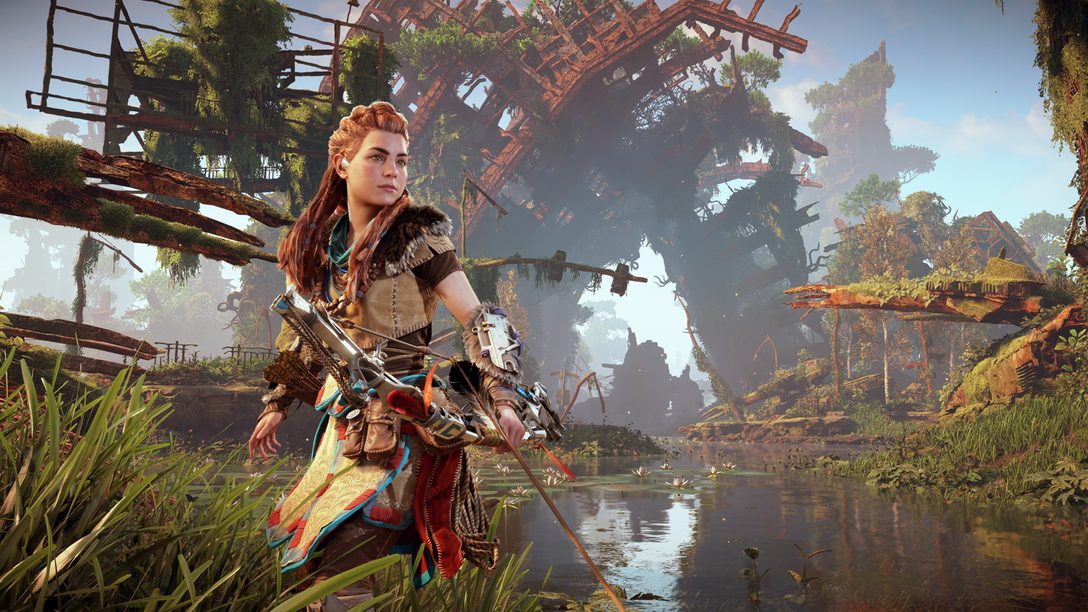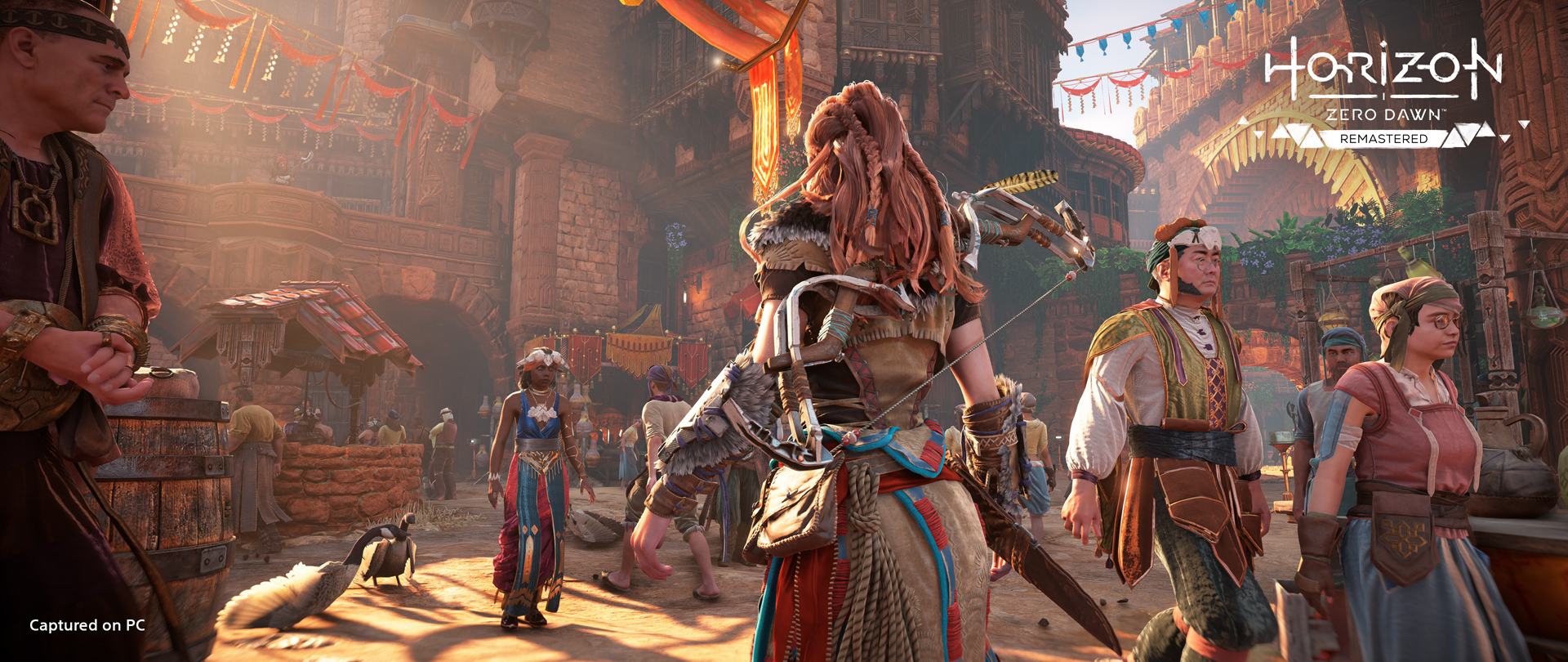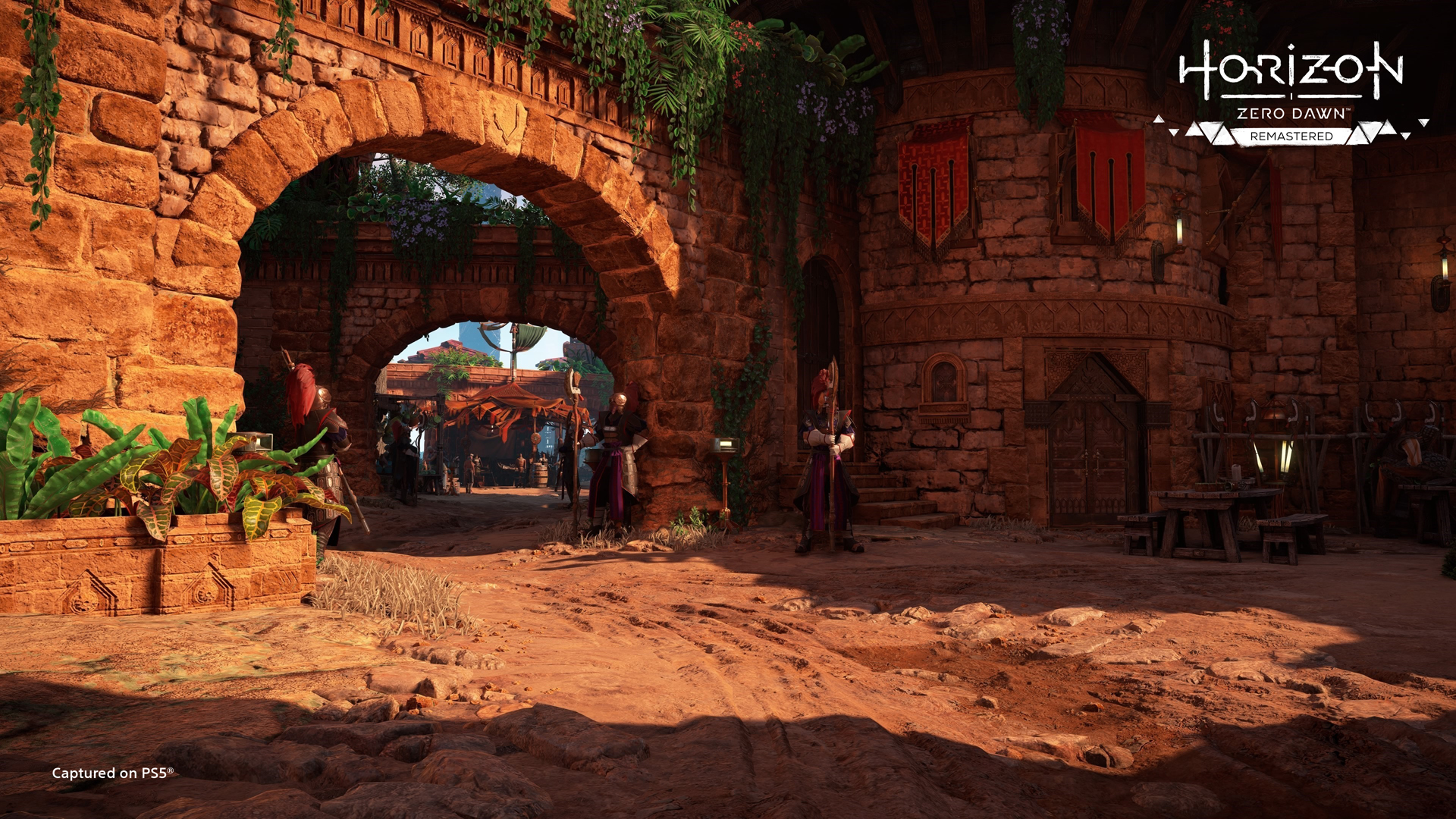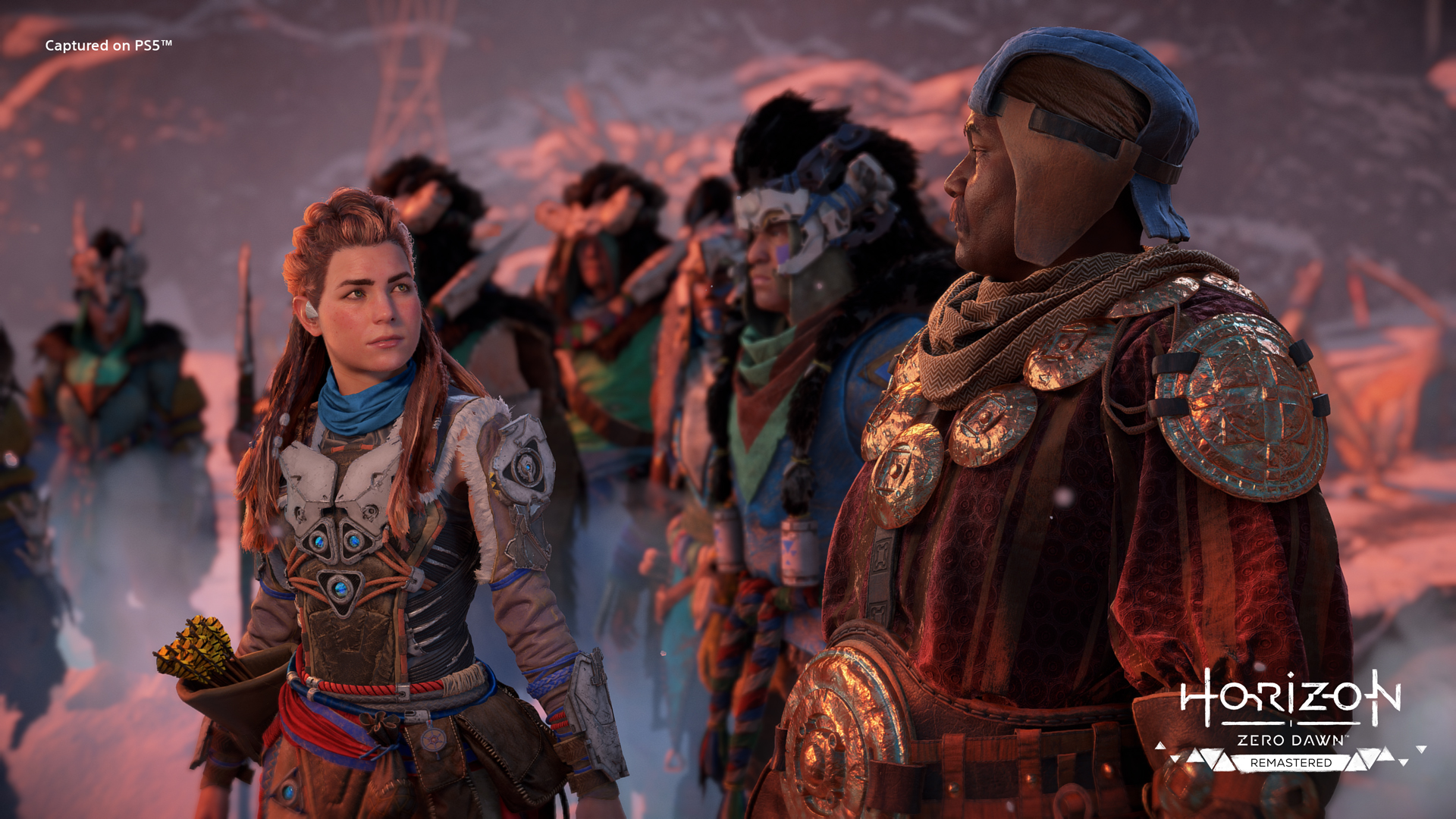
Nixxes shares developer insights on remastering Guerrilla’s action adventure for PS5 and PC.
Hey everyone, you may be familiar with Nixxes as the developer behind PC ports of PlayStation games, but behind the scenes we have also been hard at work on a project of a very different nature. Working closely with our friends at Guerrilla, we set out to create Horizon Zero Dawn Remastered for both PS5 and PC.
In our announcement last month, we shared details of improved features and technology, such as the completely revamped sound mix by Guerrilla’s audio team, support for DualSense controllers, and new motion capture for conversations. Today, I’d like to introduce you to some of the team members at Nixxes to give you more insight into some of the enhancements that have been made in the remaster.
Overhauling nature
Foliage plays a big role in portraying the lush, overgrown ruins of a long-lost civilization in the world of Horizon. Our team of Environment Artists considered the foliage in Horizon Zero Dawn to be an industry standard, and Horizon Forbidden West added to that with significant improvements in visual quality. For the remaster, the team wanted to give the foliage the same care and attention.
Patrick Blankenzee, Senior Environment Artist: “To bring the foliage in the remaster up to the same level of quality as in Horizon Forbidden West, we enhanced the shaders, textures, geometry and foliage interaction. We assessed all the foliage assets in Horizon Zero Dawn and upgraded them with all these new features. We did this for hundreds of plants, bushes, flowers and trees.”
“We looked at the biomes in the original game and compared them to the concept art. We found places that we could enhance and bring closer to the original intent, with the rainforest biome being a good example of this. With powerful procedural technology, we injected new foliage and raised the quality and density to new heights. The riverbanks have also been upgraded with more biodiversity to bring them closer to the original intention as seen in the concept art.”

Julian Hofman, Environment Artist: “Working with the original team over at Guerrilla, we were able to ask questions, and directly compare their latest work on Horizon Forbidden West to the work we were doing for the remaster. This gave us some very specific goals to work towards, like the fresh generation of moss that you can now see Horizon Zero Dawn Remastered.”
“For me, the foliage changes make the game feel more alive and make it live up to the incredibly high standards of the Horizon games. The result is a coherent world to replay or experience for the first time.”

Enhancing the living world
The Design team at Nixxes made several key improvements to Horizon Zero Dawn Remastered. One of the most significant changes is the enhancement of the living world.
Brian van Nunen, Senior Technical Game Designer: “To achieve this, we reviewed all villages, outposts and cities, identifying areas that felt empty or where we could improve realism and immersion.”
“Building the game for PS5 allowed us to leverage the increased amount of memory available, enabling us to significantly boost the number of non-player characters. We added many more places for NPCs to stand, sit, work and fulfil their needs. We gave them more varied schedules to increase movement and liveliness in different areas. We also tried to make creative use of existing animations. For example, there is now a woman feeding geese at the well in Meridian, reusing an existing sowing animation. Additionally, on the bridge to Meridian, we’ve made significant strides in improving the atmosphere and sense of activity.”

Improving terrain and building blocks
Our Tech Art team used the library of next-gen materials that were created for Horizon Forbidden West to enhance the quality of assets used for terrain, objects and buildings significantly in the remaster.
Sander Bronkhorst, Senior Technical Artist: “We began by replacing all the Horizon Zero Dawn terrain materials with their new Horizon Forbidden West counterparts. This was only the first step, as the sequel’s terrain materials didn’t always align with the original aesthetics. To address this, we carefully tweaked and polished each individual terrain material to closely match the look and feel of the original game, while maintaining the visual fidelity of the terrain materials in Horizon Forbidden West.”
“In addition to updating all the terrain textures and materials, we incorporated features like deformable snow and sand. Snow deformation was first introduced in the Frozen Wilds expansion, but in the remaster, you will find this feature outside that area as well.”
“In settlements like Meridian and Daytower, the ground required a more unique aesthetic. Previously, Guerrilla used custom meshes and materials for the floors in these settlements, exclusive to these locations. For the remaster, we initially followed this approach, exploring the possibility of increasing texture resolution and adding parallax mapping to areas such as brick floors. However, after initial tests we concluded that in these specific cases this wasn’t going to give us the visual quality that we were aiming to achieve. Therefore, we decided to completely remake the floors in Meridian and Daytower from scratch. This involved creating new high-resolution textures, setting up new materials, painting blend maps, and creating new high-resolution geometry supporting the shapes from the textures used in the material.”

“Another aspect of the upgrades to the game environment in the remaster are Building Blocks. To give a bit of context here: Building Blocks are the individual assets that are used for set dressing the world of Horizon Zero Dawn. Think of objects like rocks, plants, utensils and even buildings.”
“Building Blocks can be divided into two categories: natural and man-made. For both types, we increased the resolution of the textures and adjusted the level of detail (LOD) ranges to ensure higher mesh fidelity.”
“We performed a separate pass on all the man-made Building Blocks, creating new high-resolution geometry for assets that would benefit from this. We found that buildings greatly benefited from having more detailed geometry, as most were using brick-like textures on the walls without the shape of the bricks being reflected in the geometry.”
“To address this, we developed custom tools for generating more detailed geometry for these buildings. The artists used these tools to create new geometry, then manually tweaked and adjusted each individual building for the best visual result.”

Lively conversations
A big change in Horizon Zero Dawn Remastered is the addition of over 10 hours of additional motion-capture data for characters, directed and captured by Guerrilla at their motion Capture Stage in Amsterdam, making the game’s conversations much livelier and in line with those in Horizon Forbidden West. Implementing this additional data was handled by our technical artists and animators.
Mark Bazelmans, Senior Technical Artist: “Horizon Zero Dawn has almost 300 conversations and well over 3100 dialog options, so we needed to find a way to easily integrate this huge number of updated animations into the conversations. We created a tool with Python to process the almost 2500 mocap files that Guerrilla provided to replace the original animation in the conversations, removing deprecated events and replacing those with the mocap and setup.”“We then focused on creating a pipeline in Maya for our animators to easily load, edit and re-export the individual mocap files for any other edits that were needed, such as finger animation, art direction feedback and fixes. Animators could select the conversation and subsequent dialog option from a list which created the scene from scratch, or simply opened it if it already existed. Our tool referenced the characters and imported the dialogue audio, so the animators could time the movement better and create the camera cuts and layout. Later, we extended this pipeline to also include existing animations for both conversations and cinematics, as some of these also required edits. Our animators could then go into Guerrilla’s DECIMA engine and edit or change the updated conversation.”

Alexander Georgiev, Animator: Since all mocap footage comes from actors with different height or gender, there was a lot of data that needed to be covered and checked. For example, characters looking up or down too much, shoulders not matching the rest of the pose, arms clipping though clothing and fingers that are too static.”
“To solve this efficiently, we created tools to help us. With these tools we visualized helpers that brought a closer connection between working in Maya and the DECIMA engine. One example was that we could not see the eyes moving the same way as in the DECIMA engine, as that was a complex, automated system. With the toolset we created a head and eye aim helper that made it clearer where the characters were looking, and with that we knew how much we should adjust the head of a certain character.”
“We made small, automated scripts to fix shoulders and arms clipping. All these tools gave the animators a way to focus more on enhancing the acting of the characters to support what they want to say. By developing these tools, we created a strong workflow and were able to significantly speed up our iteration time per conversation.”

Mark Bazelmans, Senior Technical Artist: “Alongside the updated body animation, new facial animations were captured for the conversations. Initially this was deemed a straightforward ‘overwrite and replace’, but after seeing some of the results we decided to build a pipeline to be able to edit the updated facial animations.”
“We created tools in Maya that could process a facial animation file in proprietary format into a Maya scene with literally a talking head including audio. We also wrote our own exporter that could then export a Maya scene back to the same proprietary format.”
“Next to updating the animations in conversations, we did a pass on the camera and lighting setup for both conversations and cinematics. For the cameras, we batch updated the camera setup and values. In most conversations, the automated pass didn’t quite give the desired result because the contrast between the original movement and the new mocap was too big. The new body animations allow broader movements, often leading to characters stepping out of frame or being completely offscreen. Therefore, a manual pass was done by our Camera Layout Artists, aided by our custom DECIMA tools to easily edit cameras and settings.”
“We updated the lighting toolset to be closer to that in Horizon Forbidden West, which allows for editing settings of character and environment lighting across similar shots using a visual representation of shots. Lighting was controlled by a single setup for each character in a conversation that would apply to all dialog options in a conversation. Then our lighting artists could do their magic on a particular shot type and all similar shots of that character would be lit the same, with of course room to edit individual shots if needed. This way lighting had maximum control with as little tweaks as possible.”
Shining new light on Horizon Zero Dawn
The work for world lighting and cinematic lighting was divided between Guerrilla and Nixxes Lighting artists, with Guerrilla providing direction and technical support. The Atmospherics team at Guerrilla recreated the sweeping cloudscapes from Horizon Zero Dawn in the new Nubis cloud system from Horizon Forbidden West. The cherry on the cake was the creation of the set piece volcano cloud in the Frozen Wilds expansion, using a combination of the latest innovations in voxel cloud rendering, first pioneered in the Burning Shores expansion for Horizon Forbidden West, and traditional particle VFX.

It was important to retain the strong mood lighting in Horizon Zero Dawn Remastered, ensuring a seamless transition when playing both games back-to-back. Nixxes’ Senior Lighting Artists Myvanwy Broers, Niels Iburg, and Lighting Artist Thomas Schrama talk about their approach and workflow:
“A lot of the world lighting had to be rebalanced or re-lit from scratch to reach the same mood and to bring it in line with the slightly updated art direction. Horizon Forbidden West has some workflow improvements that we used for the remaster, making the process quite enjoyable!”
“To use the improved features to their fullest potential, we revised all the atmospherics settings that control the biomes within the game world. This included changing the light intensities to Physically Based Rendering values. This is true for the sun and the moon itself, but also detailed lighting in areas such as caves and ruins that players can explore. Think of fog, the color of the sun, glow intensities and so forth.”
“This meant that after rebalancing the light intensities into PBR, it was necessary to relight entire areas to create the best visual fidelity possible. It was a joy to revisit these iconic environments to do so!”

“To speed up our workflow, we used Guerrilla’s prefab system – an object which contains geometry, particles, sound, and lights that we can place anywhere. All these assets exist as referenced content within a prefab, which means that if the value of a torch light needs adjustment, this will simultaneously happen for every torch in the world. This enables large scale changes, and high iteration speed.”
“Light bakes are an important aspect of the lighting – a system that is versatile enough for each time of day, yet providing the detailed light bounce that Horizon Zero Dawn Remastered needs. The quality of such bakes is adjustable per volume that we set as lighters, which is great when we require the light bounce to be more detailed in an area without affecting the rest. Horizon Zero Dawn Remastered uses the improved baking system from Horizon Forbidden West, resulting in at least twice as much detail in the light bounce compared to the original.”
“With lighting in cinematics and conversations, we wanted to match the art direction and visual quality of Horizon Forbidden West. This, combined with all updated animations, motion-capture and camera shots, meant we built all the cinematic lighting in the remaster from scratch. We used a lot of new technology and workflow that was created for the cinematic lighting in Horizon Forbidden West.”
“Horizon Zero Dawn used a lighting rig around each character with roughly two lights. For the remaster we used the upgraded lighting rig from the sequel, which uses five lights in total: one key-light, two profile-lights and two rim-lights. These lights are then tweaked on a per shot basis changing position, orientation, color and intensity.”

Detailed characters
Horizon Zero Dawn Remastered features significant upgrades to character models and how they react to lighting. Many enhancements in areas such as detail, skin tones, hair quality, and outfits have been carried over from Horizon Forbidden West.
Patrick Blankenzee, Senior Environment Artist: “Working on the varied cast of characters in the remaster was a big undertaking. We enhanced various shaders to improve the visual quality and made changes to ensure the models react better to the new lighting in the remaster. We gave Aloy’s model – both adult and child – the full cinematic treatment, including peach fuzz, upgrades to hair, eyes and materials.”
“We looked at the original concept art of Aloy as a child and aimed to make changes to her outfit, hair and skin, to match the look envisioned in the concept art, as well as bring the model up to par with the quality of the improved model for adult Aloy.”
“In Horizon Zero Dawn, only the character model for Aloy reacts to environmental elements like weather. For the remaster we wanted to give all companion characters the same level of interaction to bring that cinematic feel to the whole world. For example, you will now see both Aloy and her companions react to warm and cold weather.”
On behalf of the teams at Nixxes and Guerrilla, we cannot wait for you to experience Aloy’s journey (again) with all the visual enhancements, upgraded features and tech improvements.
Horizon Zero Dawn Remastered is available for pre-order now and launches on October 31 on PS5 and PC (Steam, Epic Games Store). Account for PlayStation Network required on PC.
Existing owners of Horizon Zero Dawn and Horizon Zero Dawn Complete Edition can upgrade to the digital version of Horizon Zero Dawn Remastered for $9.99. Check out the previous announcement PS Blog post for all the upgrade details.














Comments are closed.
58 Comments
Loading More Comments